Colen Campbell
| Colen Campbell | |
|---|---|
| Born |
15 June 1676 Brodie |
| Died |
13 September 1729 London |
| Nationality | Scottish |
| Occupation | Architect |
| Buildings |
Mereworth Castle Stourhead Houghton Hall Burlington House Wanstead Park |
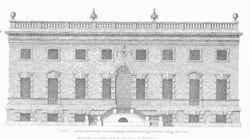
Colen Campbell (15 June 1676 – 13 September 1729) was a pioneering Scottish architect and architectural writer, credited as a founder of the Georgian style. For most of his career, he resided in Italy and England.
A descendent of the Campbells of Cawdor Castle, he is believed to be the Colinus Campbell who graduated from the University of Edinburgh in July 1695.[1] He initially trained as a lawyer, being admitted to the Faculty of Advocates on 29 July 1702.
He had travelled in Italy from 1695–1702 and is believed to be the Colinus Campbell who signed the visitor's book at the University of Padua in 1697. He is believed to have trained in and studied architecture under James Smith,[2] this belief is strengthened by Campbell owning several drawings of buildings designed by Smith.
Vitruvius Britannicus
His major published work, Vitruvius Britannicus, or the British Architect... appeared in three volumes between 1715 and 1725. (Further volumes using the successful title were assembled by Woolfe and Gandon, and published in 1767 and 1771.) Vitruvius Britannicus was the first architectural work to originate in England since John Shute's Elizabethan First Groundes. In the empirical vein, it was not a treatise but basically a catalogue of design, containing engravings of English buildings by Inigo Jones and Sir Christopher Wren, as well as Campbell himself and other prominent architects of the era.
In the introduction that he appended and in the brief descriptions, Campbell belaboured the "excesses" of Baroque style and declared British independence from foreigners while he dedicated the volume to Hanoverian George I. The third volume (1725) has several grand layouts of gardens and parks, with straight allées, for courts and patterned parterres and radiating rides through wooded plantations, in a Baroque manner that was rapidly becoming old-fashioned.
Buildings were shown in plan, section and elevation, but also some were in a bird's-eye perspective. The drawings and designs contained in the book were under way before Campbell was drawn into the speculative scheme. The success of the volumes was instrumental in popularising neo-Palladian Architecture in Great Britain and America during the 18th century. For example, Plate 16 of Vitruvius Britannicus, a rendering of Somerset House in London, was an inspiration for American architect Peter Harrison when he designed the Brick Market in Newport, Rhode Island, in 1761.[3]
Campbell was influenced as a young man by James Smith (ca 1645 – 1731), the pre-eminent Scots architect of his day, and an early neo-Palladian whom Campbell called "the most experienced architect" of Scotland (Vitruvius Britannicus, ii).
The somewhat promotional volume, with its excellently rendered engravings, came at a propitious moment at the beginning of a boom in country house and villa building among the Whig oligarchy. Campbell was quickly taken up by Lord Burlington, who replaced James Gibbs with Campbell at Burlington House in London and set out to place himself at the center of English neo-Palladian architecture. In 1718, Campbell was appointed deputy to the amateur gentleman who had replaced Wren as Surveyor General of the Royal Board of Works, an appointment that Burlington is certain to have pressed, but a short-lived one. When Benton, the new Surveyor was turned out of office, Campbell went with him.
Campbell's main commissions
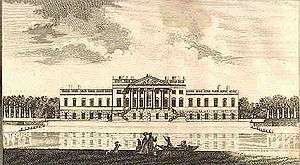
- Wanstead House, Essex: ca 1713/4 – 20 (illustrated left) In the first volume of Vitruvius Britannicus the most influential designs were two alternatives for a palatial Wanstead House, Essex, for the merchant-banker Sir Richard Child, of which the second design was already under way when the volume was published. (Campbell claimed that Wanstead House had Great Britain's first classical portico, but this accolade probably belongs to The Vyne, Hampshire.)
- Burlington House, London 1717. Remodelled the front and provided an entrance gateway for Richard Boyle, 3rd Earl of Burlington (Remodelled in 1868 and the gateway demolished.)
- Stourhead, Wiltshire, 1721–24, as a seat for the London-based banker Henry Hoare. Wings were added in the later 18th century, and Campbell's portico was not executed (though to his design) until 1841. The famous landscape garden round a lake, somewhat apart from the house, was developed after Campbell's death, by Henry Flitcroft.
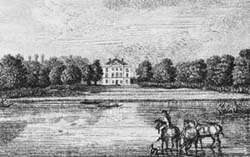
- Pembroke House, Whitehall, London, for Henry Herbert, 9th Earl of Pembroke, 1723, a London house in a prominent location for the heir of Jones' Wilton House. It was rebuilt in 1757 and demolished in 1913. Lord Herbert (as he then was) was inspired by it to design the similar Marble Hill at Twickenham for Henrietta Howard, Countess of Suffolk, the mistress of the future George II. (Marble Hill was a 5-bay palladian villa with central pediment, raised on a high basement, with clumped screens of trees and formal turfed terraces descending to the Thames, illustrated right, that manifest the earliest stages of the English landscape garden.)
- Houghton Hall, Norfolk, begun 1722, for Sir Robert Walpole, the Whig prime minister. Here Campbell was replaced by Gibbs, who capped the end pavilions with octagonal domes, and by William Kent, who designed the interiors.
- Mereworth Castle, Kent 1722 – 25: Campbell's most overtly palladian design, based on Villa La Rotonda, capped with a dome with no drum, through which 24 chimney flues pass to the lantern.
- Waverley Abbey, Surrey ca 1723–25 for John Aislabie (largely altered)

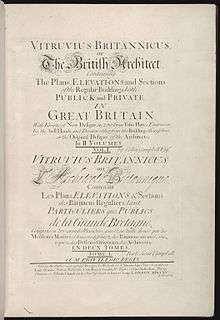
- Nos 76 and 78 Brook Street, London W1, 1725 – 26. No. 76, which survives, was Campbell's own house, the designs for its interiors published in his Five Orders of architecture, (1729). It carries a blue plaque commemorating him.
- Compton Place, Eastbourne, Sussex, 1726 onwards, south front and extensive internal rebuilding for Sir Spencer Compton
List of architectural works[4]
- Shawfield Mansion, Glasgow (1712) demolished (1792)
- Wanstead House, Essex (1714–15) demolished (1822)
- Hedworth House, Chester-le-Street (1726)
- Hotham House, Beverley (1716–17) demolished (c.1766)
- Burlington House, London, south front, and west wing (1717) subsequently extended and several occasions
- Burlington (Ten Acre Close) Estate, London, layout (1717–18)
- Burlington House, Great Gate and Street Wall (1718)
- Rolls House, Chancery Lane, London (1718), demolished (1895–96)
- Ebberston Lodge, Ebberston, Yorkshire, including cascade (1718)
- 34 Great Burlington Street, London (1718–19)
- 33 Great Burlington Street, London (1719–20)
- 32 Great Burlington Street, London (c.1720); this was Campbell's own house
- 31 Great Burlington Street, London (1719–24) rebuilt
- Burlington Girls' Charity School, Boyle Street, London (1719–21)
- Wimbledon Manor House, Surrey, for Sir Theodore Janssen (1720); completion uncertain
- Newby Park, (now Baldersby Park), near Topcliffe, Yorkshire (1720–21)
- Houghton Hall, Norfolk; one of several architects to work on the building (1721–22)
- Stourhead, Wiltshire, the portico part of Campbell's design was only added in 1840 (1721–24); interiors destroyed by fire (1902)
- Mereworth Castle, Kent (1722–23)
- Pembroke Lodge, Whitehall, London acted as executed Henry Herbert, 9th Earl of Pembroke's design (c.1724), demolished (1756)
- Plumptre House, Nottingham (1724)
- Hall Barn, Buckinghamshire, garden buildings: Great Room (only partially survives), Temple of Venus, Obelisk & Doric Pavilion (1724)
- Waverley Manor, Surrey (c.1725), later extended (1770), damaged by fire and rebuilt (1833)
- Greenwich Hospital, Greenwich, London; additions to Queen Mary block and Queen Anne block (1726–29)
- Compton Place, Eastbourne, remodelled house (1726–29)
- 76 Brook Street, London, internal alterations (c.1726); became Campbell's new home
- Hackney House, Hackney, London (c.1727), demolished (before 1842)
- Althorp, Northamptonshire, new stables, loggia gate (c.1729–33)
- Lydiard House, Lydiard Tregoze, Wiltshire (c.1729)
- Studley Royal Park, Yorkshire, the stables (c.1729) built after his death by Roger Morris (1695–1749)
Gallery of architectural work
 Design for Stourhead, Vitruvius Britannicus vol. 3, 1725.
Design for Stourhead, Vitruvius Britannicus vol. 3, 1725. Stourhead, showing later wings and portico added to Campbell's design in 1840
Stourhead, showing later wings and portico added to Campbell's design in 1840 Houghton Hall, Vitruvius Britannicus vol. 3, 1725
Houghton Hall, Vitruvius Britannicus vol. 3, 1725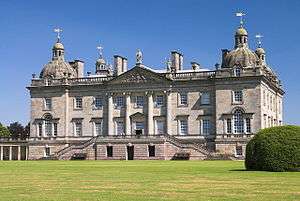 Houghton Hall, as built, with domes by James Gibbs
Houghton Hall, as built, with domes by James Gibbs Houghton Hall
Houghton Hall Mereworth Castle, Vitruvius Britannicus vol 2., 1720
Mereworth Castle, Vitruvius Britannicus vol 2., 1720 cross section, Mereworth Castle, Vitruvius Britannicus vol 2., 1720
cross section, Mereworth Castle, Vitruvius Britannicus vol 2., 1720 Gate Burlington House, Vitruvius Britannicus vol 2., 1720 (demolished)
Gate Burlington House, Vitruvius Britannicus vol 2., 1720 (demolished) Wanstead House
Wanstead House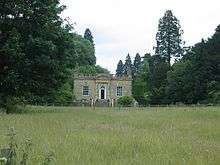 Ebberston Lodge
Ebberston Lodge The Elevation of General Wade, his house in great Burlington Street, Vitruvius Britannicus, vol. 3, 1723
The Elevation of General Wade, his house in great Burlington Street, Vitruvius Britannicus, vol. 3, 1723
References
- ↑ page 7, Catalogue of the Drawings Collection of the Royal Institute of British Architects: Colen Campbell, John Harris 1973, Gregg International Publishers Ltd
- ↑ page 7, Catalogue of the Drawings Collection of the Royal Institute of British Architects: Colen Campbell, John Harris 1973, Gregg International Publishers Ltd
- ↑ The Center for Palladian Studies in America, Inc., "Palladio and Patternbooks in Colonial America."
- ↑ pages 145–47, The Architecture of Colen Campbell, Howard E. Stutchbury, 1967, Manchester University Press
| Wikimedia Commons has media related to Colen Campbell. |
- Howard Colvin, A Biographical dictionary of British Architects, 3rd edition
- Robert Tavernor, Palladio and Palladianism 1991